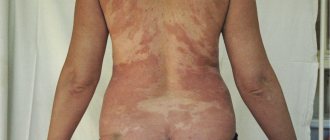Mushroom poisoning – how long does it take for symptoms to appear? This question interests many lovers of “silent hunting,” both beginners and experienced ones. The prognosis for this pathology can be different, because it depends not only on what kind of mushroom the patient was poisoned with, but also on how quickly the symptoms arose and at what stage the request for specialized medical help occurred.
Absolutely anyone at any age can be poisoned by mushrooms.
In this article we will look at the causes of poisoning, find out which mushrooms can cause poisoning, and dispel some of the myths that guide people when picking mushrooms. We will also get acquainted with the symptoms that accompany this disease and methods of providing feasible assistance in this situation.
Types and characteristics of poisonous mushrooms
There are a large number of mushrooms, some of them are conditionally poisonous and cause poisoning only under a certain number of circumstances, while others are absolutely poisonous and can even lead to death. Each poisonous mushroom has its own characteristics, in addition, they all contain different toxic substances, and, therefore, cause different symptoms.
The most famous poisonous mushrooms
As we know, cap mushrooms can be divided into lamellar and tubular. This difference can be seen if you look at the bottom of the mushroom cap. It should be noted that the most dangerous poisonous mushrooms are lamellar mushrooms.
Since there are a lot of poisonous mushrooms, we will consider only a few of them:
- Poisonous entoloma has several varieties, one of which is spring entomola. The toxic substances that make up this mushroom tend to bind to blood proteins, causing strong signs of poisoning, but are not fatal.
- Patouillard fiber - it is quite difficult to distinguish this mushroom from edible ones, however, if you break the cap, a strong smell of alcohol will appear - this feature is key, and helps to distinguish this mushroom from other species. The spores contain muscarine and other toxic substances, so it is strictly forbidden to inhale it. In addition, this mushroom is extremely poisonous when eaten even in small quantities and can be fatal.
- Amanita - there are such species as: spring, stinking, toadstool, panther, gray and red. The spring fly agaric contains muscarinic poisons, which cause death with minimal exposure to the human body.
- The stinking fly agaric has an unpleasant odor, and the composition of toxic substances is similar to the pale toadstool.
- The toadstool has the greatest resemblance to the pale grebe, not only in the composition of toxic substances, but also in appearance.
- The panther fly agaric has a similar coloration to the red fly agaric, but its appearance is not as bright. In addition, panther fly agaric is much more poisonous than red fly agaric, since it contains not only muscarinic toxic substances, but also scopalamine and hyocyamine. This mix of poisons leaves no chance of survival for a person who has consumed panther fly agaric. It should be noted that in the place where this mushroom grows there are absolutely no midges and insects, since they die when they inhale its smell.
- The gray fly agaric is a type of mushroom that also contains muscarinic toxins.
- The red fly agaric has a bright color, which by its appearance warns of danger. The fungus contains poisons that tend to penetrate the skin and also affect the parasympathetic nervous system. The pulp of the mushroom contains a high concentration of cholines, muscarinic poisons, putrescine, iboteic acid, bufotenine and betaine.
- The gall mushroom is quite often mistaken for edible porcini mushrooms, but the main differences are the pronounced bitter taste and the color of the mushroom cap on the underside. Due to the strong bitter taste, gall fungus poisoning is quite rare, however, if it occurs, it can take a long time to appear.
- Pale toadstool looks like russula or champignons, depending on the growth period. Even heat treatment of the mushroom does not reduce its toxic properties, and the first symptoms of poisoning may not appear for more than a day. Less than half of an adult mushroom eaten is fatal.
- Brick-red false mushrooms have a pronounced property of camouflaging themselves as normal types of mushrooms, and therefore often fall into the “catch” of a mushroom picker. A distinctive feature of false mushrooms is considered to be the missing dense ring on the stem of the mushroom, which is necessarily observed in edible autumn mushrooms. Poisoning with false honey mushrooms affects the central nervous system and cardiovascular system, and without proper assistance it can lead to coma and death.
After reading the information about some types of mushrooms, it becomes clear that the time the first signs appear depends on the amount of mushrooms consumed, as well as on their type. So, signs of poisoning can appear within a few minutes, hours, in the first day, or make themselves felt after a couple of weeks.
Often you feel sick immediately a few minutes after eating
Botulism
Improperly prepared or stored mushrooms, such as canned mushrooms, can cause botulism.
Botulism is a serious and serious disease that develops as a result of an infection entering the body, located mainly in the ground, next to the spores of the mycelium. If the mushroom is poorly washed, peeled, or not sufficiently boiled, an infection can enter the body.
The first signs of botulism appear 12-72 hours after eating mushrooms.
The main symptoms of botulism are:
- Nausea and vomiting;
- Visual impairment (everything floats, doubles);
- Convulsions;
- Diarrhea;
- Headache;
- Labored breathing;
- Dry mouth.
Important! At the first signs of botulism, i.e. After eating canned mushrooms, consult a doctor immediately!
Causes
You can be poisoned not only by poisonous mushrooms, but in about 1/3 of cases, poisoning occurs with edible or conditionally edible species of mushrooms, since not only the presence of poisons in the mushroom composition plays a role, but also many other factors.
Let's look at the reasons why poisoning occurs:
- When eating poisonous mushrooms, the main reason is the effect of the toxins that make up the mushroom on the body. The severity of the poisoning and which body system will be attacked first depend on the type of fungus.
- When any type of mushroom is cooked incorrectly, toxins are released from bacteria, which actively multiply due to improper cooking. A prime example in this case is botulism.
- Eating mushrooms of low quality - wormy, old, infected with mushroom flies, growing in contaminated soil, near highways or in an industrial zone. In this case, mushrooms are able to accumulate heavy metal salts and toxins from the outside, and cause poisoning.
- Incorrect storage conditions for fresh or already cooked mushrooms.
- Drinking alcohol together with certain types of mushrooms.
- Individual intolerance to this type of mushroom, or consumption of mushrooms in childhood.
It is not advisable for children under three years of age to eat forest meat.
Note! Abuse of edible mushrooms in large quantities can also cause poisoning and cause disturbances in the gastrointestinal tract.
Be careful, mushrooms!
The “poisonous” rating is topped by: toadstool, satanic mushroom, fly agaric, and false honey fungus. There are about 30 more species of mushrooms inedible for humans. There are also conditionally edible mushrooms in the mushroom kingdom. With proper heat treatment, such forest gifts become absolutely harmless, but they should absolutely not be consumed raw.
By the way, the cause of food poisoning from mushrooms can also be 100% edible mushrooms if they grow in areas contaminated with radiation, near industrial enterprises, busy highways or railways. Fans of “mushroom hunting” should remember that radionuclides accumulate most in boletus!
False judgments when picking mushrooms
Which of us, being inexperienced in mushroom picking, has not listened to the advice of knowledgeable people? Some argue that poisonous mushrooms have a specific smell, or that they are always healthy.
Let's look at the most common erroneous judgments:
- The smell of edible mushrooms is always pleasant, but poisonous mushrooms have an extremely bad smell - bitter, pungent, alcoholic, putrid, etc. In fact, this is a misconception; for example, toadstool smells the same as mushrooms.
- Another misconception is that insect larvae cannot be found in poisonous mushrooms.
- At the beginning of growth, poisonous mushrooms are edible, since they do not have time to release toxins - another very dangerous misconception.
- Another “horror story” says that in a decoction of poisonous mushrooms, silver can turn black, onions or garlic turn brown, and milk, together with such mushrooms, sours.
Just because a mushroom is wormy does not mean it is harmless.
The first prejudices about the edibility or inedibility of mushrooms were even described in English literature in 1526.
Enterosgel and food poisoning
The fact is that Enterosgel absorbs toxins and bacteria. It quickly and easily passes through the digestive tract without damaging the mucous membranes and without disturbing the normal intestinal microflora. Enterosgel reduces the severity of poisoning by absorbing the products of secondary inflammation and metabolic disorders. Enterosgel is also prescribed to treat the consequences of food poisoning: dysbiosis, liver and kidney dysfunction.
Treatment of food poisoning at home involves replenishing fluid lost through diarrhea and vomiting. At home, after each bowel movement or bout of vomiting, you should take about a glass of liquid in small sips after each vomiting and bowel movement.
If the patient does not have diarrhea, a laxative should be added to Enterosgel to speed up the removal of toxins from the intestines.
In case of mushroom poisoning, it is strictly forbidden to take alcohol, medications for diarrhea and vomiting.
Remember! The body is unable to neutralize mushroom poisons on its own. Don't waste time! If you have a food allergy or mushroom poisoning, seek medical help immediately!
Symptoms
Toxic damage by mushrooms has a lot of manifestations and depends on which body system was affected. Both the number of mushrooms eaten and their type play a role in how long it takes for symptoms of mushroom poisoning to appear.
The gastrointestinal tract and central nervous system are most often affected: nausea and vomiting, pain in the stomach and intestines, thirst, cold sweat, and diarrhea occur. In many cases, convulsions and headaches, sharp constriction of the pupils, coldness of the extremities and a decrease in blood pressure are observed.
Don't underestimate the severity of your condition
In addition, with mushroom poisoning, salivation and sweating may increase, suffocation and hallucinations may occur. Consumption of certain types of mushrooms affects liver cells, impairs blood clotting, provokes nosebleeds and increased heart rate.
In severe cases, poisoning leads to coma and death. This can only be avoided with the help of specialized treatment.
If there has been poisoning with cytotoxic poisons, symptoms of kidney or liver failure, sudden loss of consciousness, severe pain in the head and repeated vomiting develop. In the future, chronic toxic changes in the kidneys, liver or brain may develop.
Even edible mushrooms should not be eaten by children under 5 years of age.
Fly agaric poisoning
Many, having heard enough tales on the Internet and on TV, are ready to believe in the miracle of healing and, despite doctors’ prohibitions, take fly agaric tinctures made “according to healer’s recipes.” Do not forget that fly agaric poison acts on the nervous system, so the first symptoms of intoxication look like a headache with dizziness, and in severe cases drowsiness and impaired consciousness occur.
Nausea, drooling, vomiting and watery eyes are other common signs of mushroom poisoning. How long does it take for them to appear? Typically after a few hours. Colic, dilated pupils, diarrhea and cramps also occur. Even hallucinations and delusions are possible! If help is not provided for poisoning with poisonous mushrooms, liver failure, jaundice, respiratory arrest and coma develop.
First aid
First aid instructions include precise execution of all points. It should be noted that even if a person’s condition has improved with first aid, this does not mean that qualified assistance is not needed. It is impossible to completely get rid of toxins in the body without special treatment, since they penetrate from the gastrointestinal tract into the blood and spread throughout the body.
First of all, you need to make sure whether the dish that caused the poisoning is left. This is necessary so that the doctor can determine the type of fungus and select the correct treatment. Then you need to call an ambulance and proceed to first aid.
The patient should rinse the stomach - drink at least 5-6 glasses of clean boiled water and induce vomiting. After gastric lavage, you need to give the patient a laxative or give an enema. The next step is to give the person to drink at least 10 tablets of activated carbon, or 4-5 smecta sachets (for children - 2 sachets).
Important! The patient should not be given any medications before the ambulance arrives, as their interaction with mushroom toxins will be unpredictable, and the cost of such self-medication may be too high and lead to death.
In a hospital setting, blood transfusions and alkalization, injections with atropine and intravenous sodium saline are used, as well as symptomatic treatment and vitamin therapy.
From the photos and videos in this article we received information about the types of poisonous mushrooms and the causes of poisoning. In addition, we learned how long it takes before the first signs appear, and how to provide first aid in this situation.
Satanic mushroom
Quite a bit different from the real “white” ones in appearance, this mushroom often becomes the “prey” of inexperienced mushroom pickers. The satanic mushroom skillfully disguises itself as everyone’s favorite porcini mushroom, for which mushroom pickers sometimes call it “mushroom Judas.” The poison of “Satan” primarily affects the human nervous system: this is manifested by headaches, hallucinations, and disorientation in space and time. Worried about vomiting, diarrhea, nausea. Symptoms appear within a couple of hours and last up to three days.
Remember: timely assistance in case of poisoning with poisonous mushrooms will save the victim’s life!
In addition to diarrhea and vomiting, poisoning from poisonous plants and mushrooms can manifest as enlarged liver, spleen, kidney failure and jaundice.






